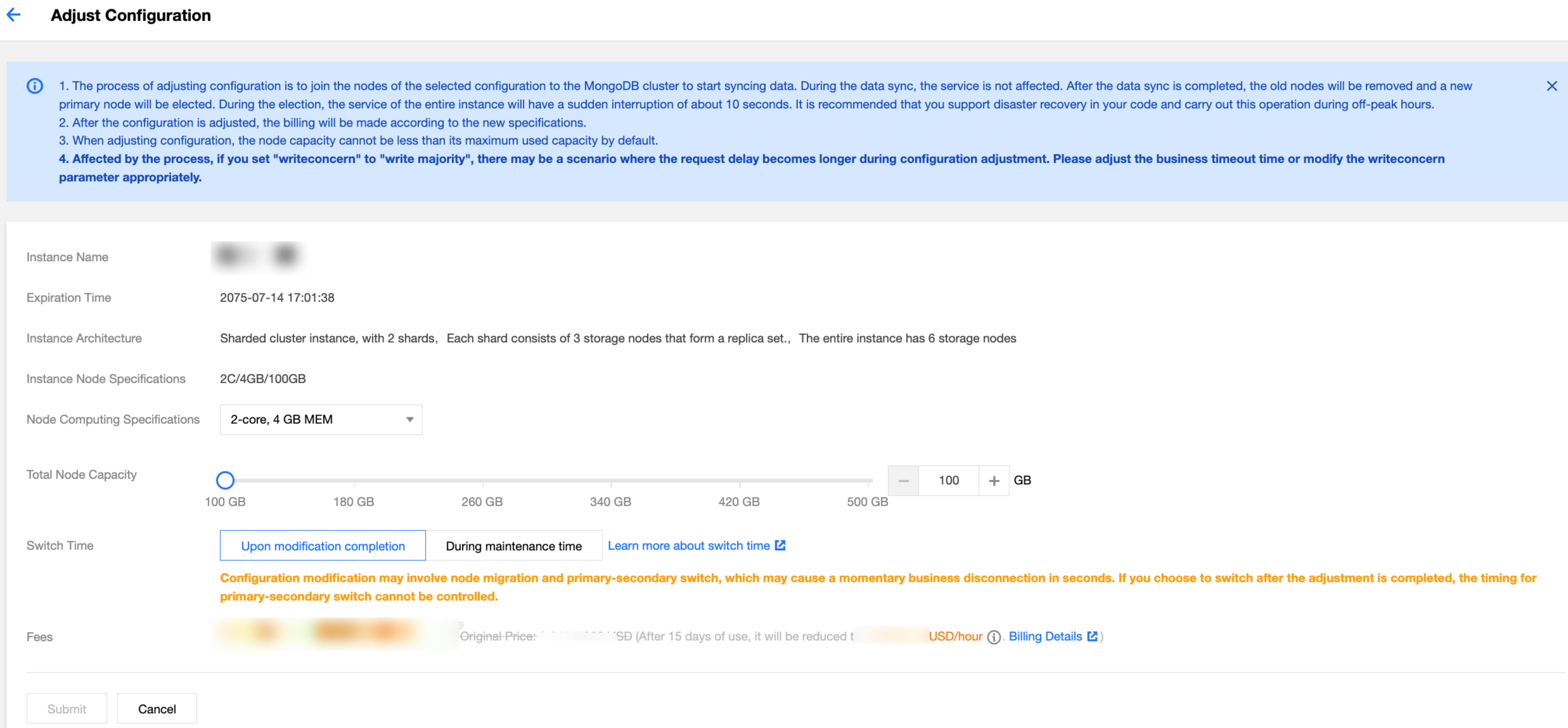Adjusting Mongod Node Specification
Last updated: 2025-08-19 17:52:48
Overview
If your purchased TencentDB for MongoDB instance is over-provisioned or under-provisioned, your business needs cannot be best met, and you can quickly adjust its specifications as needed (at the start, during rapid development, or during peak/off-peak hours), so you can get the most out of your resources and reduce unnecessary costs in real time.
You can change the computing specification and disk capacity for mongod nodes. In order to choose the specifications that best suit your needs, we recommend that you first check TencentDB Product Specifications before making a choice.
Billing Overview
The instance will be billed by the new specifications after its specifications are changed. Make sure that your Tencent Cloud account balance is sufficient to cover the updated billing. For more information, see Specification Adjustment Billing.
Prerequisites
You have created a TencentDB for MongoDB instance. For more information, see Creating TencentDB for MongoDB Instance.
If your instance is pay-as-you-go, make sure that your Tencent Cloud account balance is sufficient.
The instance and its associated instances are in Running status and and there are currently no tasks being executed.
How Expansion Works and Impacts
If there are sufficient physical machine resources where the node resides, the storage space will be expanded in this node. This expansion process does not require any migration or switching between nodes, ensuring uninterrupted connections..
If there are insufficient physical machine resources where the node resides, expanding the storage space will require cross-node data migration. After the expansion task is initiated, the system will create nodes and sync data as required by new specifications, and perform the switch as scheduled. As a momentary disconnection of about 10s will occur during the switch, we recommend that you include the reconnection mechanism in your business code and perform the adjustment during off-peak hours. The higher volume of data, the longer time it takes to complete the configuration adjustment.
Note:
After the scaling operation is executed, the system will re-trigger a new automatic backup task.
Notes
During adjustment, there may be one or two momentary disconnections for about 10s each. We recommend that you configure an automatic reconnection feature for your application.
During adjustment, if you set the write concern level to write majority, there may be a short request delay; therefore, it is advisable to set an appropriate business timeout period.
The name, private network address, and port of the instance remain unchanged after specification adjustment.
A started specification adjustment task cannot be canceled.
After the instance is upgraded, we recommend that you adjust the Oplog capacity to avoid having a small Oplog size. This is important to prevent data overwriting, which could potentially impact the rollback feature of MongoDB. For more information, see Adjusting Oplog Capacity.
Directions
1. Log in to the TencentDB for MongoDB console.
2. In the MongoDB drop-down list on the left sidebar, select Replica Set Instance or Sharded Cluster Instance. The directions for the two types of instances are similar.
3. Above the Instance List on the right, select the region.
4. In the instance list, find the target instance.
5. In the Operation column of the target instance, select Adjust Configuration in the drop-down list.
6. On the Adjust Configuration page, you can adjust the node memory and total node capacity.

Parameter | Description | Example |
Instance Name | The name of the instance that requires specification adjustment. | test-4dot2-XXX |
Expiration Time | The expiration time of the instance, specifically for subscription-based billing, serves as a reminder for the instance's expiration date. | 2022-04-24 19:23:43 |
Instance Architecture | The description of the instance's cluster architecture. For more information, see System Architecture. | A sharded cluster instance has two shards, and each shard consists of three storage nodes to form a replica set. Hence, the entire instance has six storage nodes in total. |
Instance Node Specifications | The specifications of a single Mongod node in the current instance include: number of CPU cores, memory capacity, and disk size. | 2C/4GB/10GB |
Node Computing Specifications | In the dropdown list, reselect the specifications for a single Mongod node. For detailed guidance on selecting specifications, please refer to the Mongod specifications outlined in Product Specifications. | 4 GB/100 GB MEM |
Total Node Capacity | Adjust the total disk capacity per mongod node on the slider, which is the same as the total capacity of the current node by default. For how to choose a specification, see the mongod specifications in Product Specifications. Note: When adjusting disk capacity, it must be at least 120% of the currently used capacity. | 500 GB MEM |
Switch Time | If you select Upon modification completion, the instance specification adjustment task will be executed immediately. Instance memory and disk adjustment may involve node migration or primary-secondary switch. As the switch time is uncontrollable, disconnection or restart may occur. If you select During maintenance period, the task will be executed during the maintenance period. For more information, see Setting Instance Maintenance Period. | During maintenance period |
Fees | Pay-as-you-go: The hourly billing rate after instance configuration adjustments. Click Billing Details to view billing items, pricing formulas, and confirm the charges. | 177.991 USD |
7. After confirming that everything is correct, click Submit.
Related APIs
API Name | Description |
Adjusts the specifications of a TencentDB instance |
Was this page helpful?
You can also Contact Sales or Submit a Ticket for help.
Yes
No
Feedback

